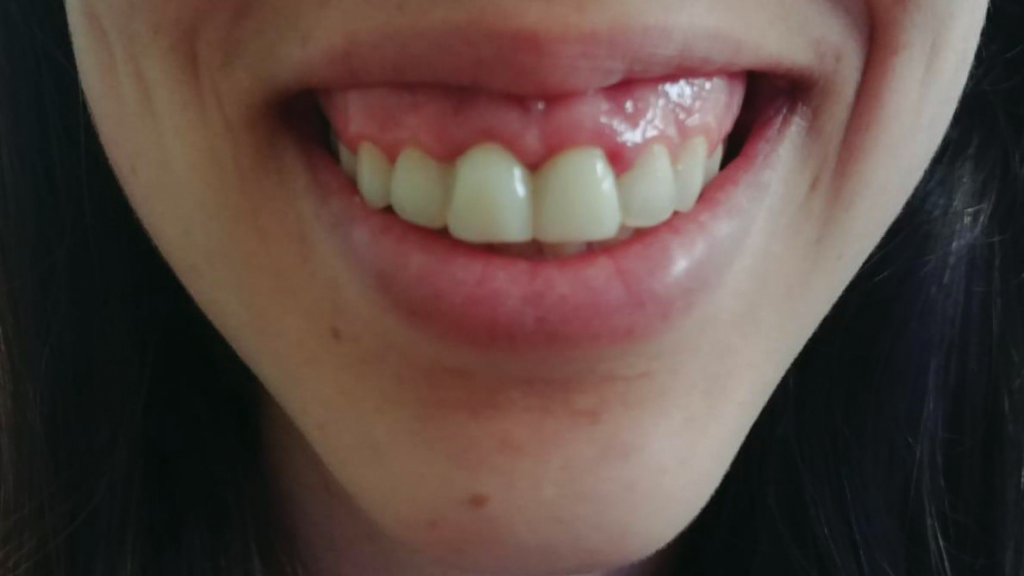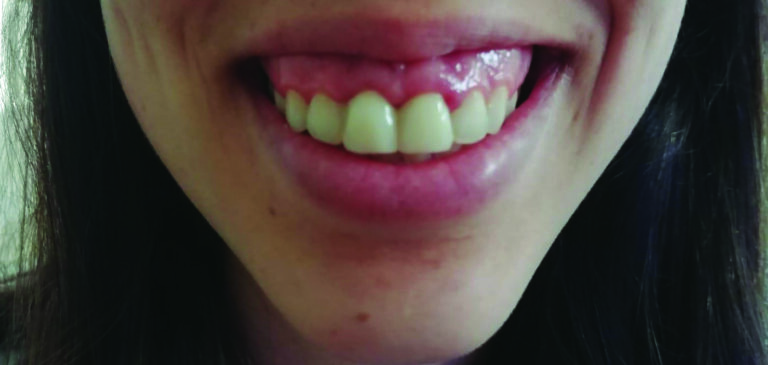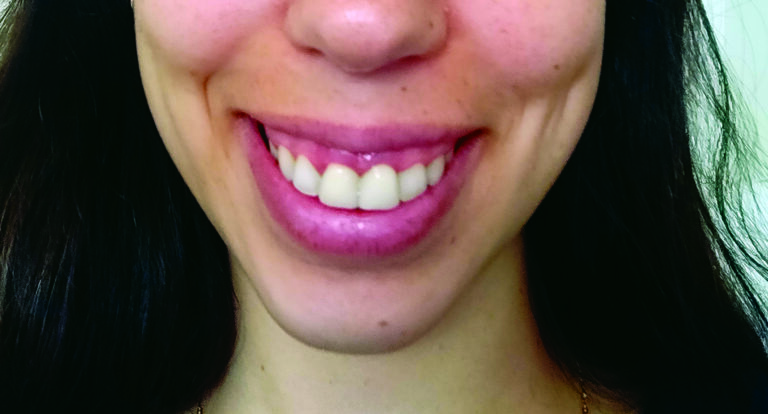
ABSTRACT
In modern culture, a beautiful smile is often considered a sign of intelligence, wealth, and success. Besides the position and shape of the teeth, some significant factors of a beautiful smile are the characteristics of the gingival tissue. A gummy smile has more than 2 mm of exposed gingiva and is a common cause of facial esthetics insecurities.
As social awareness of facial esthetics increased, some noninvasive treatment options were developed. This case representation is intended to present such treatment for a 28-year-old female with an 8 mm severe gummy smile. The method of treatment is presented, and the use of Botulinum Toxin type A is discussed.
Abeautiful smile is a crucial feature of facial esthetics. However, approximately 7% of men and 14% of women display excessive gingival expression when smiling.1 The smile results from three components: the teeth, the gingiva and the lips.2 Several facial muscles are involved in the smile: Zygomaticus major, Zygomaticus minor, Levator labii superioris, Alaeque nasi, and Risorius.3 The muscles, once contracting, cause elevation of the upper lips and may expose the gingiva.
GINGIVAL EXPOSURE HAS THREE CATEGORIES:
- Low smile line. No gingival exposure at all
- Equigingival smile line- exposing a minimal amount of gingiva. Where the lips meet the cervical borders of the maxillary terror teeth
- High smile line exposing varying degrees of gingiva.4
A gingival exposure of 2+ mm while smiling is called a gummy smile (GS). Some individuals consider a GS an esthetic issue and will investigate correcting it.
The purpose of this article is:
- To present and report a case with 8 mm severe GS.
- To discuss the injections of Botulinum Toxin (BT) as an easy, fast, and noninvasive treatment option for patients with a GS.
CASE PRESENTATION
A 28-year-old Caucasian woman came in for a consultation in a private practice. Her main concern was the severe gingival exposure while smiling. After the assessment, there were no significant findings regarding the patient’s health. She was not taking any medications and had no allergies. Initial photographs were taken (Fig. 1).
Fig. 1

- 8 mm of gingival exposure was noted during her full smile in the anterior upper region from canine to canine.
- 6 mm of gingiva was exposed to the canines in the distal area.
The patient expressed her dissatisfaction with her smile and the mental effect this has had on her life. She is not able to take photographs of herself or even smile in public. Hand-over-mouth was her mechanism to hide her unesthetic smile. The patient refused to discuss crown lengthening, lip repositioning, or referral to a Maxillofacial surgeon to evaluate for orthognathic surgery. The option of Botulinum Toxin A injections was presented, and it was the preferred mode of treatment for the patient.
METHODS
100-unit BT- XEOMIN injection (Merz Therapeutics) was used for this case, diluted in 2.5 cc 0.9% Sodium Chloride solution following the manufacturer’s guide on dilution. Topical anesthesia of a cream containing 15% Lidocaine and 5% Prilocaine was applied. A 0.5 ml syringe was used for the injection with a 31-gauge needle.
First visit: Four units of BT were injected into the subcutaneous tissue, bilateral and symmetrical at the conjunction point of the three muscles involved in the smile. The needle was inserted adjacent to the end of the ala of the nose. The patient was advised not to lie down or to exercise for four hours following the injections. The follow-up was eight days from the first visit. Upon examination at the follow-up visit, a minor reduction in gingival exposure during smile was noted. (Fig. 2)
Fig. 2

Second visit: Two units of BT were added on each side bilaterally adjacent to the end of the ala of the nose.
Third visit: A significant improvement was noted on the third follow-up and eight days later. Gingival exposure was only 4-5 mm (Fig. 3). The patient was satisfied with the results but asked if it was possible to improve them. An additional two BT units were injected on each side. At this visit, 0.5 ml of Hyaluronic acid (Revanesse, KISS, Canada) was injected into the lip’s vermilion border to give better volume to the upper lip. This procedure increased the volume of the lips slightly, helping them shadow the remaining exposed gingiva better. As a result, a more esthetic smile harmony was achieved (Figs. 4 & 5).
Fig. 3

Fig. 4

Fig. 5

DISCUSSION
The science behind the smile is well documented in literature. It has been established that a smile has a tremendous impact on perceptions of one’s attractiveness and one’s personality. Attractive people are perceived as more successful, intelligent, and friendly.5 Undoubtedly, a person who perceives their smile as esthetic will have more confidence when smiling or laughing, thereby, as established above transferring these positive perceptions to others.
A gummy smile is a familiar phenomenon and can present esthetic issues. This is attributed to several factors, including hyperfunction of the perioral muscles, lip length, clinical crown length, skeletal problems caused by maxillary excess, and delayed passive eruption resulting in gingival issues.
Today, there are a variety of ways to treat a gummy smile. They are divided into invasive (surgical) and non-invasive (botulinum toxin and hyaluronic acid injection into the lips). First, we will start with the surgical way. Treatment of excessive gingival display usually involves invasive procedures such as Le Fort impaction under general anesthesia or maxillary gingivectomies or modified lip repositioning technique while using local anesthesia.1
In contrast, botulinum toxin injections can be considered a viable noninvasive option. Botulinum toxin has been clinically used for three decades to treat several conditions associated with excessive muscle contraction, such as strabismus, cervical dystonia, blepharospasm, and hemifacial spasm. In the last two decades, BT has been widely used for the cosmetic treatment of hyper-functional facial lines. More recently, BT has emerged as an effective, minimally invasive tool to combat gummy smiles for patients with hyper-functional upper lip.6
Many articles describe the use of botulinum toxin A with great results lasting about six months. A few articles describe a number of cases of gummy smiles, which initially measured the amount of gums exposed with a smile. In most studies, 2.5 units were injected on each side and waited between one and two weeks to see the results. If necessary, they’ve added another dose of botulinum toxin A3’4.
Psychologically and socially, an unesthetic smile can damage self-confidence and the desire to smile publicly. In some cases, people avoid social events and experience varying degrees of depression as a result. It can cause depression and become unsocial. Especially nowadays, at the age in which we live, TV, social networks, and billboards where we see people with perfect smiles make everyone wish for such a smile.
In the case described above, the young woman described insecurity in her smile; she was often photographed from a distance or not with a big smile so that it would not stand out. After getting the BT treatment at the dentist, she was delighted with her smile and used it more often. 
Oral Health welcomes this original article.
References
- Ishida, L. H. et al. Myotomy of the levator labii superioris muscle and lip repositioning: A combined approach for correcting a gummy smile. Plast. Reconstr. Surg. 126, 1014–1019 (2010).
- Mazzuco, R. & Hexsel, D. Gummy smile and botulinum toxin: A new approach based on the gingival exposure area. J. Am. Acad. Dermatol. 63, 1042–1051 (2010).
- Polo, M. Botulinum toxin type A (Botox) for the neuromuscular correction of excessive gingival display on smiling (gummy smile). Am. J. Orthod. Dentofac. Orthop. 133, 195–203 (2008).
- Suber, J. S., Dinh, T. P., Prince, M. D. & Smith, P. D. OnabotulinumtoxinA for the treatment of a ‘gummy smile’. Aesthetic Surg. J. 34, 432–437 (2014).
- Beall, A. E. Can a New Smile Make You Look More Intelligent and Successful ? 51, 289–297 (2020).
- Indra, A. S., Biswas, P. P., Vineet, V. T. & Yeshaswini, T. Botox as an Adjunct to Orthognathic Surgery For A Case of Severe Vertical Maxillary Excess. 10, 266–270 (2011).
About the Authors:

Dr. Milli Harel Raviv was the head of the Department of Preventive and Community Dentistry at McGill University and had a private practice at the Jewish General Hospital in Montreal. She has been involved with research and has published dozens of articles in the past 40 years.

Dr. Eli Raviv is an Associate professor in the Faculty of Dentistry at McGill University. He has received numerous awards and has been involved in teaching and researching implant dentistry for the past 40 years. He has published in local and international peer-reviewed journals.

Dr. Roy Raviv completed his DMD at McGill University and completed a comprehensive multidisciplinary residency program at the Jewish General Hospital. He is currently an Assistant Professor in the Department of Restorative Dentistry and Prosthodontics at McGill University.

Dr. Alona Madjar earned her DMD degree in 2022 and has since focused her practice on pediatric dentistry.









